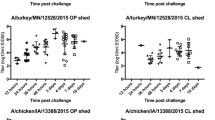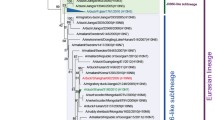Abstract
A comparative study examining replication and disease pathogenesis associated with low-pathogenic H5N1, H5N2, or H5N3 avian influenza virus (AIV) infection of chickens and ducks was performed. The replication and pathogenesis of highly pathogenic AIV (HPAIV) has received substantial attention; however, the behavior of low-pathogenic AIVs, which serve as precursors to HPAIVs, has received less attention. Thus, chickens or ducks were inoculated with an isolate from a wild bird [A/Mute Swan/MI/451072/06 (H5N1)] or isolates from chickens [A/Ck/PA/13609/93 (H5N2), A/Ck/TX/167280-4/02 (H5N3)], and virus replication, induction of a serological response, and disease pathogenesis were investigated, and the hemagglutinin and neuraminidase (NA) gene sequences of the isolates were determined. Virus isolated from tracheal and cloacal swabs showed that H5N1 replicated better in ducks, whereas H5N2 and H5N3 replicated better in chickens. Comparison of the NA gene sequences showed that chicken-adapted H5N2 and H5N3 isolates both have a deletion of 20 amino acids in the NA stalk region, which was absent in the H5N1 isolate. Histopathological examination of numerous organs showed that H5N2 and H5N3 isolates caused lesions in chickens in a variety of organs, but to a greater extent in the respiratory and intestinal tracts, whereas H5N1 lesions in ducks were observed mainly in the respiratory tract. This study suggests that the H5N1, H5N2, and H5N3 infections occurred at distinct sites in chicken and ducks, and that comparative studies in different model species are needed to better understand the factors influencing the evolution of these viruses.




Similar content being viewed by others
References
Alexander DJ (2000) A review of avian influenza in different bird species. Vet Microbiol 74:3–13
Banks J, Speidel ES, Moore E, Plowright L, Piccirillo A, Capua I, Cordioli P, Fioretti A, Alexander DJ (2001) Changes in the haemagglutinin and the neuraminidase genes prior to the emergence of highly pathogenic H7N1 avian influenza viruses in Italy. Arch Virol 146:963–973
Baigent SJ, McCauley JW (2001) Glycosylation of haemagglutinin and stalk-length of neuraminidase combine to regulate the growth of avian influenza viruses in tissue culture. Virus Res 79:177–185
Beigel JH, Farrar J, Han AM, Hayden FG, Hyer R (2005) Avian influenza (H5N1) infections in humans. N Engl J Med 353:1374–1385
Bosch FX, Orlich M, Klenk H-D, Rott R (1979) The structure of the hemagglutinin, a determinant for the pathogenicity of influenza viruses. Virology 95:197–207
Boycott R, Klenk H-D, Ohuchi M (1994) Cell tropism of influenza virus mediated by hemagglutinin activation at the stage of virus entry. Virology 203:313–319
Brown JD, Stallknecht DE, Beck JR, Suarez DL, Swayne DE (2006) Susceptibility of North American ducks and gulls to H5N1 highly pathogenic avian influenza viruses. Emerg Infect Dis 12:1663–1670
Campitelli L, Mogavero E, De Marco MA, Delogu M, Puzelli S, Frezza F, Facchini M, Chiapponi C, Foni E, Cordioli P, Webby R, Barigazzi G, Webster RG, Donatelli I (2004) Interspecies transmission of an H7N3 influenza virus from wild birds to intensively reared domestic poultry in Italy. Virology 323:24–36
Fouchier RA, Munster V, Wallensten A, Bestebroer TM, Herfst S, Smith D, Rimmelzwaan GF, Olsen B, Osterhaus AD (2005) Characterization of a novel influenza A virus hemagglutinin subtype (H16) obtained from black-headed gulls. J Virol 79:2814–2822
Hinshaw VS, Air GM, Gibbs AJ, Graves L, Prescott B, Karunakaran D (1982) Antigenic and genetic characterization of a novel hemagglutinin subtype of influenza A viruses from gulls. J Virol 42:865–872
Horimoto T, Kawaoka Y (1994) Reverse genetics provides direct evidence for a correlation of hemagglutinin cleavability and virulence of an avian influenza A virus. J Virol 68:3120–3128
Kawaoka Y, Yamnikova S, Chambers TM, Lvov DK, Webster RG (1990) Molecular characterization of a new hemagglutinin, subtype H14, of influenza A virus. Virology 179:759–767
Lee CW, Senne DA, Linares JA, Woolcock PR, Stallknecht DE, Spackman E, Swayne DE, Suarez DL (2004) Characterization of recent H5 subtype avian influenza viruses from US poultry. Avian Pathol 33:288–297
Lee CW, Suarez DL, Tumpey TM, Sung HW, Kwon YK, Lee YJ, Choi JG, Joh SJ, Kim MC, Lee EK, Park JM, Lu X, Katz JM, Spacemen E, Swayne DE, Kim JH (2005) Characterization of highly pathogenic H5N1 avian influenza A viruses isolated from South Korea. J Virol 79:3692–3702
Lee CW, Swayne DE, Linares JA, Senne DA, Suarez DL (2005) H5N2 avian influenza outbreak in Texas in 2004: the first highly pathogenic strain in the United States in 20 years? J Virol 79:11412–11421
Lewis DB (2006) Avian to human influenza. Annu Rev Med 57:139–154
Li SQ, Orlich M, Rott R (1990) Generation of seal influenza virus variants pathogenic for chickens, because of hemagglutinin cleavage site changes. J Virol 64:3297–3303
Matrosovich M, Zhou N, Kawaoka Y, Webster R (1999) The surface glycoproteins of H5 influenza viruses from humans, chickens, and wild aquatic birds have distinguishable properties. J Virol 73:1146–1155
OIE (2006) Manual of diagnostic tests and vaccines for terrestrial animals. http://www.oie.int/eng/normes/mmanual/A_00037.htm
Pillai SP, Suarez DL, Pantin-Jackwood M, Lee CW (2008) Pathogenicity and transmission studies of H5N2 parrot avian influenza virus of Mexican lineage in different poultry species. Vet Microbiol 129:48–57
Reed LJ, Muench H (1938) A simple method of estimating fifty per cent endpoints. Am J Hyg 27:493–497
Rohm C, Zhou N, Suss J, Mackenzie J, Webster RG (1996) Characterization of a novel influenza hemagglutinin, H15: criteria for determination of influenza A subtypes. Virology 217:508–516
Slemons RD, Johnson DC, Osborn JS, Hayes F (1974) Type-A influenza viruses isolated from wild free-flying ducks in California. Avian Dis 18:119–124
Spackman E, Swayne DE, Suarez DL, Senne DA, Pedersen JC, Killian ML, Pasick J, Handel K, Pillai SP, Lee CW, Stallknecht D, Slemons R, Ip HS, Deliberto T (2007) Characterization of low-pathogenicity H5N1 avian influenza viruses from North America. J Virol 81:11612–11619
Stallknecht DE, Shane SM (1988) Host range of avian influenza virus in free-living birds. Vet Res Commun 12:125–141
Sturm-Ramirez KM, Hulse-Post DJ, Govorkova EA, Humberd J, Seiler P, Puthavathana P, Buranathai C, Nguyen TD, Chaisingh A, Long HT, Naipospos TS, Chen H, Ellis TM, Guan Y, Peiris JS, Webster RG (2005) Are ducks contributing to the endemicity of highly pathogenic H5N1 influenza virus in Asia? J Virol 79:11269–11279
Webster RG, Bean WJ, Gorman OT, Chambers TM, Kawaoka Y (1992) Evolution and ecology of influenza A viruses. Microbiol Rev 56:152–179
Webster RG, Rott R (1987) Influenza virus A pathogenicity: the pivotal role of hemagglutinin. Cell 50:665–666
Acknowledgments
This research was supported by the NIAID Center of Excellence for Influenza Research and Surveillance contract HHSN266200700006C, and the Georgia Research Alliance.
Author information
Authors and Affiliations
Corresponding author
Rights and permissions
About this article
Cite this article
Mundt, E., Gay, L., Jones, L. et al. Replication and pathogenesis associated with H5N1, H5N2, and H5N3 low-pathogenic avian influenza virus infection in chickens and ducks. Arch Virol 154, 1241–1248 (2009). https://doi.org/10.1007/s00705-009-0437-2
Received:
Accepted:
Published:
Issue Date:
DOI: https://doi.org/10.1007/s00705-009-0437-2




